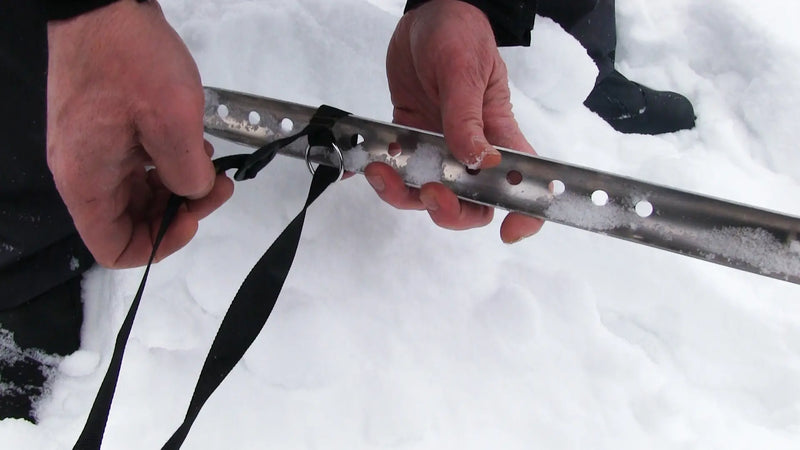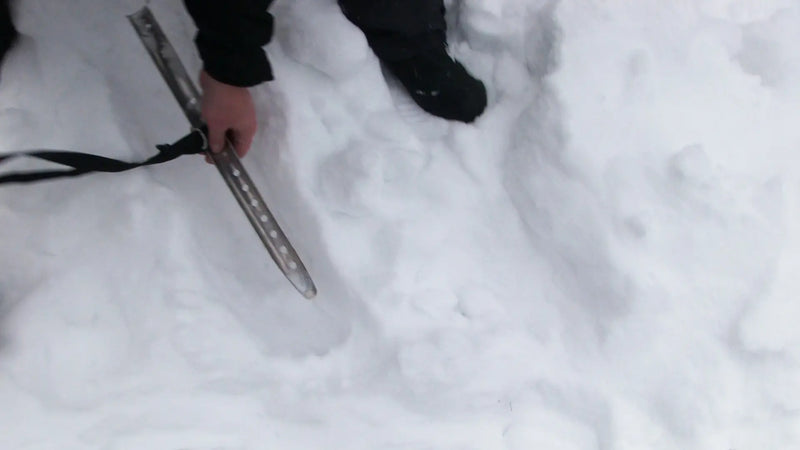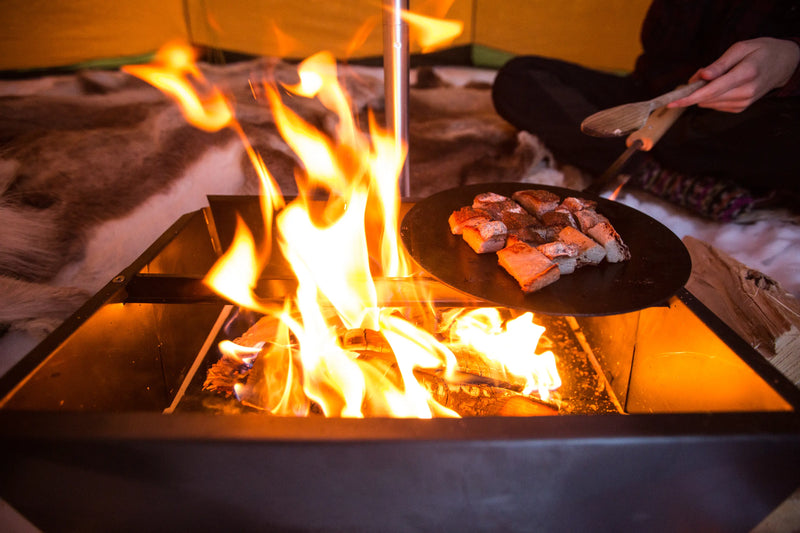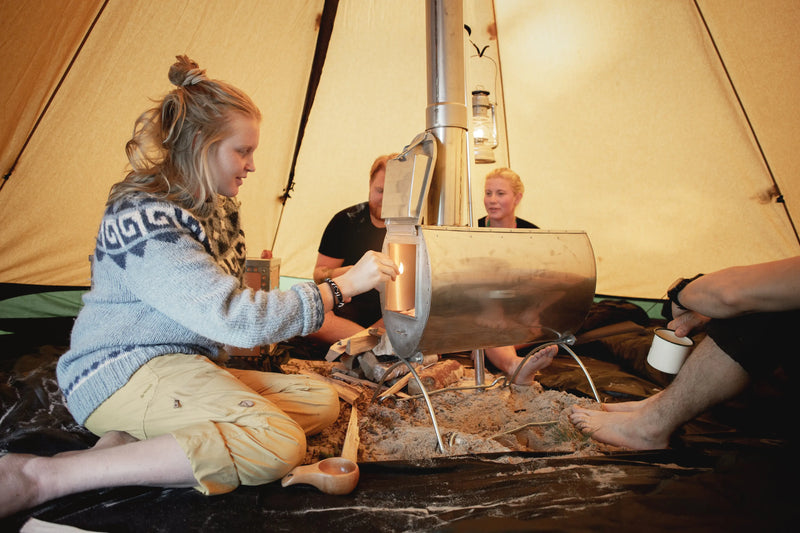Prepare before setting out for winter camping. Here are nine tips and tricks from Tentipi about what you need to think of before you go: the right tent for winter camping, how to pack the snow, comfort in snow, which tent pegs to use, where to pitch the tent, about snow weight, what heat sources can be combined with the tent, how to safely make a fire and other equipment.
Tent for winter camping
Choose tents according to occasion, different tent types work differently at winter camping. When it’s icy, the tent needs to be more robust than a tent which is exclusively used in summer. The tent frame needs to withstand a certain amount of snow and functional ventilation is important. If you want to use a heat source, for example a fireplace or a stove, the tent needs to have ventilation openings both at ground level and at the top. Without a heat source, a smaller tent is preferable, as it heats up faster when the air volume is smaller. A Nordic tipi, a tent from Tentipi, can be used in the most extreme conditions and climates – by polar researchers in Antarctica, adventurers on Svalbard and Johansson in motion – all year round.

Snow conditions
Snow-covered ground needs to be prepared. Pack deep snow with skis, snowmobiles or shovels and let the floor surface freeze for about half an hour – if it's nippy weather it can go faster. When it is just a thin snow cover, it is easier to shovel away the snow before you pitch the tent.
Deep snow is an advantage when camping in winter. By flattening the snow carefully using a spade, it is possible to get a smoother floor than during summer camping.
Deep snow is an advantage when camping in winter. By flattening the snow carefully using a spade, it is possible to get a smoother floor than during summer camping.
Comfortable camping in snow
In deep snow you can dig a hole to make a comfortable bench to sit on. You can create a nice sleeping place and even make a pillow out of snow.



Anchoring and pitching the Nordic tipi
In deeper snow, use snow pegs, branches or boards to anchor the tent. Dig a hole, put the pegs or nailing in the hole, pack and let it freeze. If the ground is frozen and bare – use steel pegs. Leave part of the peg above ground to be able to loosen it when it has frozen. A blow with the hammer makes the peg loosen, and it can be pulled up.
Place the central pole on hard ground, for example on our central pole plate, not to let the pole sink into the snow. Fold the snow flap, the reinforced edging that is on most of the tent models from Tentipi, outwards and put a thin layer of snow on it, this makes it harder for cold wind to enter under the edging. Let the air intakes be open.
Tips for placing the tent
Choose a place as windproof as you can find. Keep in mind that near a mountain wall, the wind can swirl. Have a distance of a few meters to what creates shelter.
Look up to avoid trees with snow that may fall over the tent.
Snow weight
Let no snow lay on the tent fabric. The snow weight may easily increase and can damage the central pole, and in worst case the people in the tent. If the central pole is damaged, you can replace it with any wooden pole/stick.


Heat source
Nordic tipis from Tentipi are designed to allow the use of an open fire or stove. Hekla fire box and Eldfell stove help you to get warm during winter camping.
Place Hekla and Eldfell on long branches, to make the fireplace comes a bit over the snow and prevents hot metal parts from melting it so that the fireplace sinks.
Safely make a fire
Follow local restrictions on outdoor fires. Never leave the fire unattended. Use fireplaces that are adapted to your tent model.
Provide good ventilation to avoid carbon monoxide poisoning. With the stove in the tent, the flue gases are carried out through the chimney opening and the risk of carbon monoxide poisoning is negligible. Leave the air intakes open until the embers have gone out.
Because of its shape and design solutions, the Nordic tipis from Tentipi have excellent ventilation and are equipped with an ingenious ventilation system. Air enters at the bottom of the tent and exits through the large top opening where there is an adjustable cap, regulated from within the tent. It is the tent’s tall shape and special ventilation system that allow you to use an open fire or a stove inside the tent. Most of the tent models are prepared with a chimney opening and our stove has an insulation pipe to prevent hot parts from contact the tent fabric.

Equipment
You need a good underlay to insulate yourself from the ground. Double sleeping pads or a thick sleeping pad are recommended. Reindeer skins are warm and cosy to lie on or sit on. Why not lay out reindeer skins on the floor like a rug, an insulating layer that is nice to walk on when you take off your shoes? Our expert in winter camping recommends a regular foam plastic sleeping pad or reindeer skin against the ground with an inflatable, thick sleeping pad filled with insulation such as down or synthetic fibres on top, and a sleeping bag for winter use.
A warm sleeping bag adapted to the temperature, or double sleeping bags are needed.
Warm clothes, feel free to bring more than you think, before you learn exactly how much you need. To stay warm, you also need to stay dry. Layer upon layer is an advantage. Then it is easy to take off or put on depending on temperature and activity. Another way is to have a set of clothes for chores that make you a little sweaty and a set to change to when you have calmed down in the tent. Wool insulates and warms even when the garment is damp.
Drink hot drinks to help the body stay warm. It is a tip to bring a thermos with hot contents and drink while you pitch the tent.
It is often said that the sleeping bag works like a thermos. If you go to bed cold and frozen, it will not warm you up. You need to be warm but not sweaty when you go to bed, so it is good to move before taking off clothes and crawling into the sleeping bag. You should not wear so much clothing in the sleeping bag, preferably only underwear and wool socks.
At your first time winter camping, it can be good to start by trying at home or where you can get inside and warm up if you are freezing. Good luck and have a wonderful winter camping.
Winter tent
Spade
Steel pegs/Snow pegs or replacement for these
Central pole plate
Heat source
Firewood
Fire steel/matches
Tinder
Sleeping pad/reindeer hide
Thicker, inflatable, insulating sleeping pad
Sleeping bag for winter use
Warm clothes – layer upon layer
Extra gloves and socks
Wool underwear
Wool socks
Hot drink
A warm sleeping bag adapted to the temperature, or double sleeping bags are needed.
Warm clothes, feel free to bring more than you think, before you learn exactly how much you need. To stay warm, you also need to stay dry. Layer upon layer is an advantage. Then it is easy to take off or put on depending on temperature and activity. Another way is to have a set of clothes for chores that make you a little sweaty and a set to change to when you have calmed down in the tent. Wool insulates and warms even when the garment is damp.
Drink hot drinks to help the body stay warm. It is a tip to bring a thermos with hot contents and drink while you pitch the tent.
It is often said that the sleeping bag works like a thermos. If you go to bed cold and frozen, it will not warm you up. You need to be warm but not sweaty when you go to bed, so it is good to move before taking off clothes and crawling into the sleeping bag. You should not wear so much clothing in the sleeping bag, preferably only underwear and wool socks.
At your first time winter camping, it can be good to start by trying at home or where you can get inside and warm up if you are freezing. Good luck and have a wonderful winter camping.
Checklist equipment
Winter tent
Spade
Steel pegs/Snow pegs or replacement for these
Central pole plate
Heat source
Firewood
Fire steel/matches
Tinder
Sleeping pad/reindeer hide
Thicker, inflatable, insulating sleeping pad
Sleeping bag for winter use
Warm clothes – layer upon layer
Extra gloves and socks
Wool underwear
Wool socks
Hot drink




